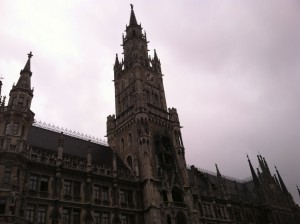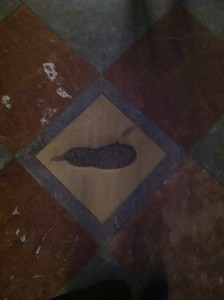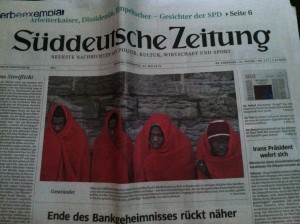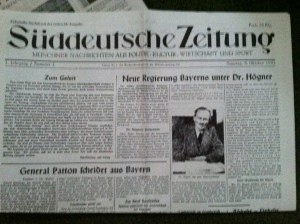by Carson Allwes
Point Park University’s International Media class arrived in Munich on Friday from the airport and straight into a tour of Germany’s third largest city.
Tour guide Arnoud Beck provided a bus tour from the airport to the hotel. Beck pointed out key points such as the Autobahn, the highway in Germany famous for not having a speed limit. The advisory speed limit is 130 kilometers or 81 miles per hour, and buses and trucks should travel at 80 kilometers per hour or around 60 miles per hour, according to the highway’s website.
Old and new buildings, including Munich’s soccer stadium, flashed by the bus windows as the bus took the group to its hotel. The hotel, Europäischer Hof, is in the center of Munich, near Marienplatz. And it was very close to the main train station, which the group used a number of times for visits.
Henry the Lion founded Marienplatz in 1158. Today it is a shopping center. Downtown Marienplatz was filled with people browsing shops, eating in cafés, visiting street vendors and enjoying outdoor street music.
Vendors set up along the streets with their carts full of fruits, vegetables and white spargel, or asparagus, which was in season. Their customers were dressed in everything from lederhosen to everyday apparel.
Marienplatz has several key points that depict Munich. Beck showed the group a couple of churches, including Bürgersaalkirche and the Frauenkirche.
Bürgersaalkirche is between two buildings and almost blends into the scenery. The church has a museum for the Rev. Rupert Mayer SJ. He was a Jesuit priest who was a chaplain in World War I, losing a leg in a grenade attack. During World War II he preached against the Nazis and was placed in “protective custody” and later sent to a concentration camp by the Nazis. He returned to a hero’s welcome from Catholics and others after the war ended and died of a stroke in November 1945. Pope John Paul II beautified him in 1987, which is a path to sainthood. The museum also displayed many other different religious statues and relics.
The Frauenkirche is the tallest building in Munich. It was decided by the city that no building should be taller than the Frauenkirche’s two towers, which are around 100 meters tall.
Beck explained why the Frauenkirche survived the war.
“The high points of the church gave the army [a marker] to bomb the city,” he said.
This saved the Frauenkirche and many other tall buildings as they were used for the military during the second war.
Inside the Frauenkirhe, Beck told the story of how the church was built. According to legend, Jörg von Halsbach needed funding in order to build the church and asked the Devil for help. The Devil would help but only if Halsbach did not put windows in the church.
Halsbach tricked the Devil by using the architecture to give the appearance of a windowless church. Devil was not fooled.
“In [the Devil’s] anger at being fooled, he [stomped] his foot and left his footprint [in the floor],” Beck said, showing it to the students.
The Frauenkirche is also the home of the archbishop. This is the church where former Pope Benedict XVI practiced as bishop before moving on to the Vatican.
Another famous piece of architecture is the Glockenspiel.
The Glockenspiel is in the center of Marienplatz, an old gothic-themed building with gargoyles and flying buttresses. The clock is in the center tower. The clock tower has two open windows with pieces that move at 11 a.m. and 5 p.m., attracting a crowd. The inner mechanics put on a show for the people in the square. The entire show lasts about 15 minutes.
Beck’s tour ended with permission to begin exploring and sampling Munich’s cafés and restaurants. The tour formed a foundation of important landmarks and history that better shaped the group’s understanding of the city over the rest of their trip.




